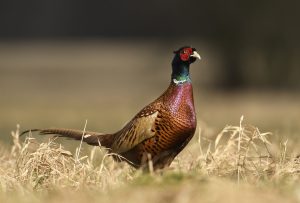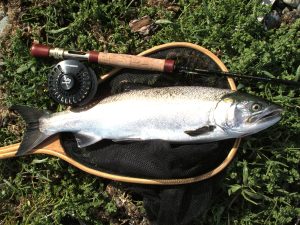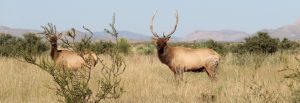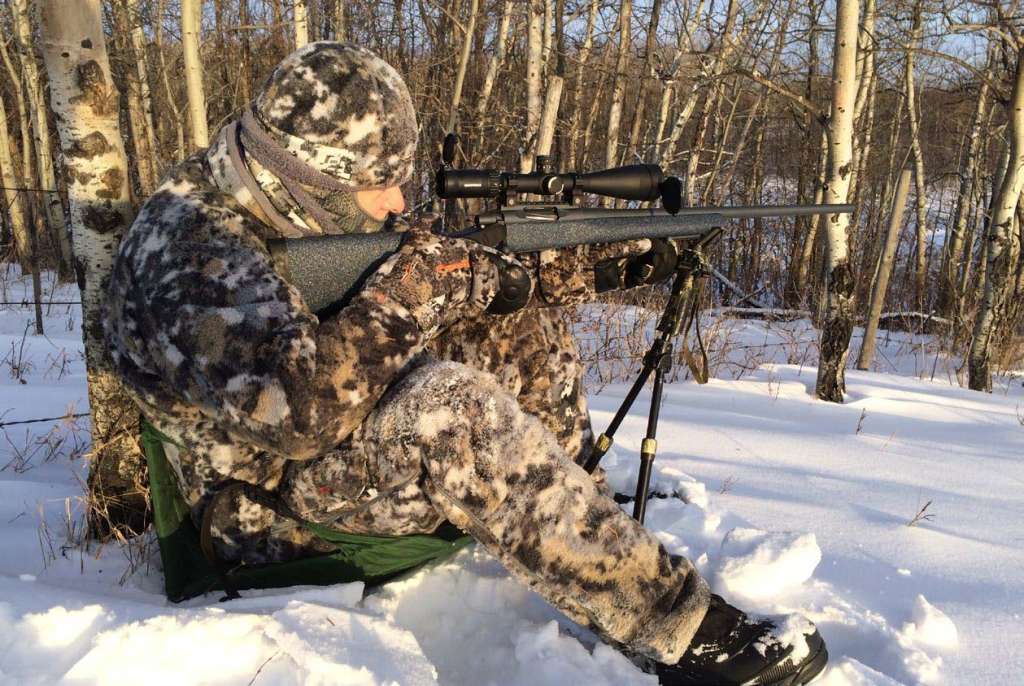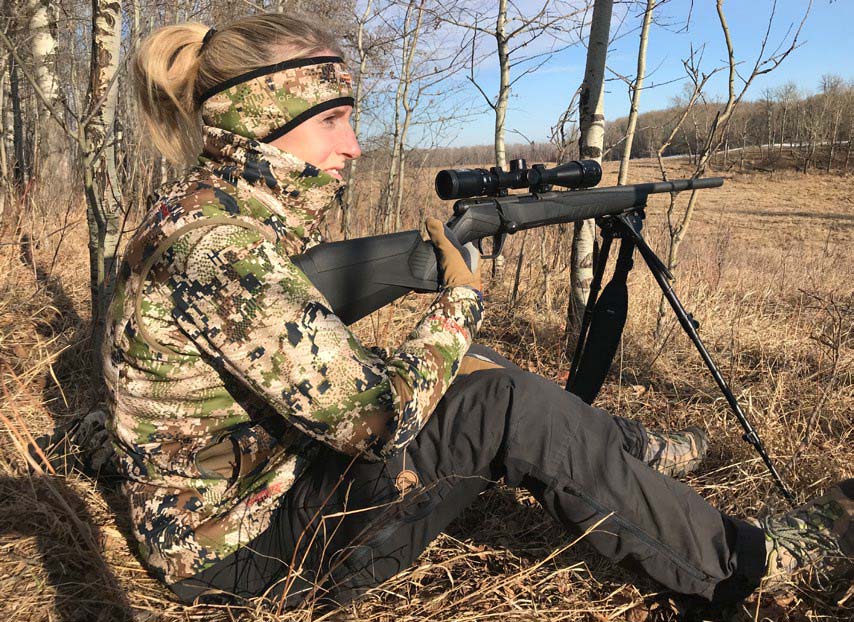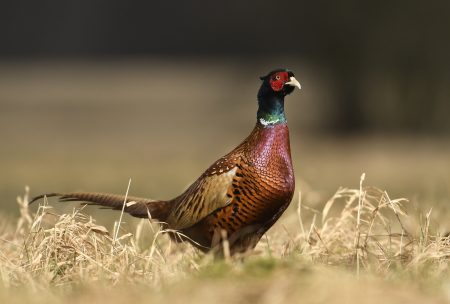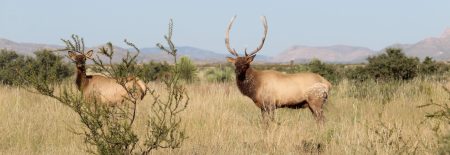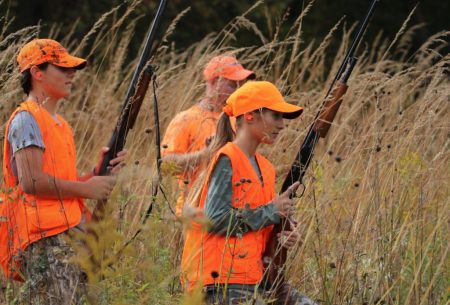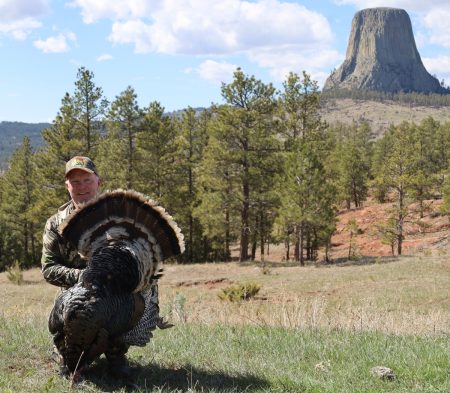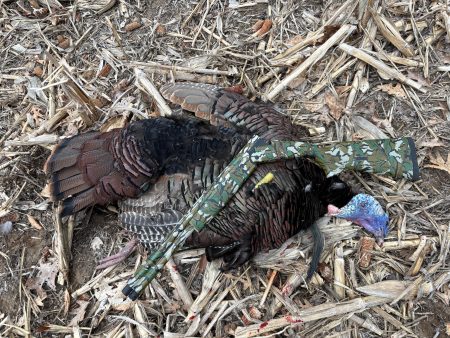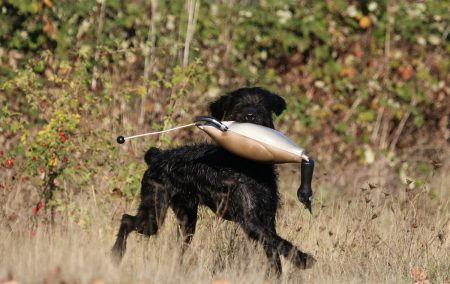Calling from prime locations and capitalizing on the roster of sounds offered by e-calls can make your set irresistible to curious and hungry coyotes.
Peering down into the deep ravine, an open hillside of patchy willows gave way to the frozen creek. It was the perfect calling location. Where there is food, there will be coyotes and from an elevated vantage point, the odds were good that we would not only avoid detection but draw in a curious, if not hungry, coyote in short order.
Down the valley, we could see 250 yards in one direction and almost 150 across to the other side. “This is a textbook scenario”, I whispered to my partner Rick. “The wind is light, and the coyotes can travel easily on the frozen ice.”
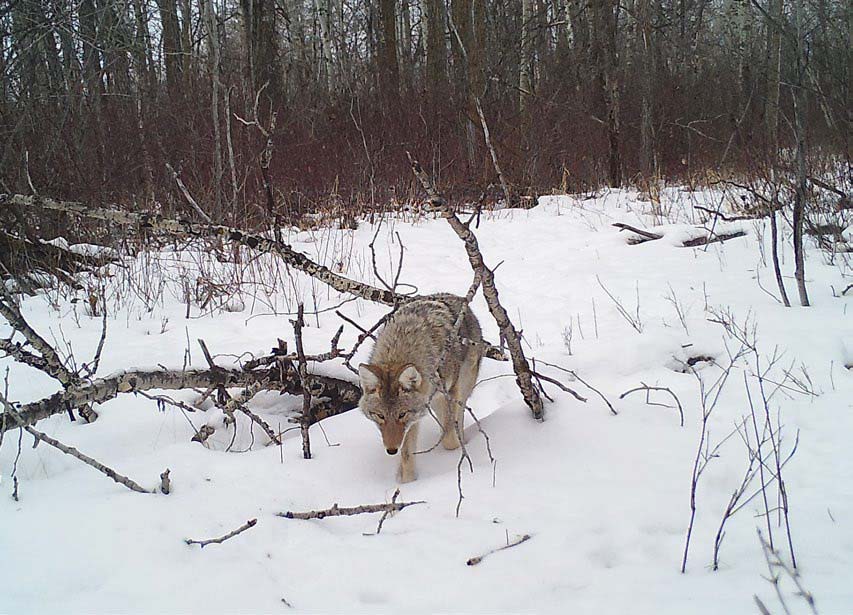
coyote vocalizations, hunters can create an enticing scenario that many coyotes simply can’t resist.
My buddy was curious, but I sensed he wasn’t entirely convinced the set-up would work. Whenever possible, I try to choose stand locations that maximize the shooter’s visibility and minimize the chance of being seen or smelled by an incoming coyote. That usually means posting up in an elevated location. Coyotes are small and can easily disappear in rolling topography. On many occasions I’ve had them slip in to less that 30 yards, simply by using the rolling landscape for concealment. This particular spot had it all. Height, visibility, and the ability to eliminate scent issues by allowing the breeze to carry our odour well above their anticipated line of travel.
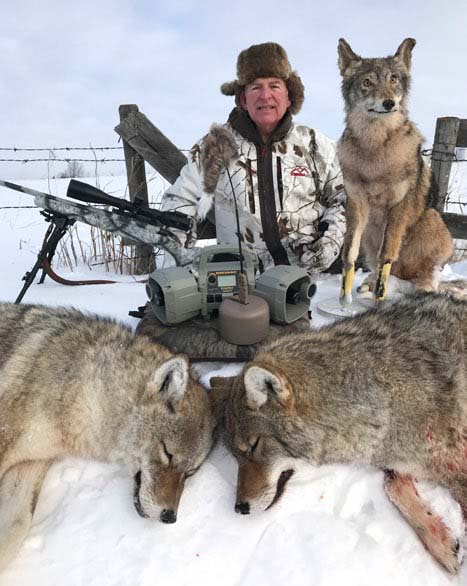
To improve our odds, I told Rick to sit tight while I slipped down to the bottom to place the e-call. The hill was steep but I was certain the effort would pay dividends. Tucking my Foxpro into a shelf near the creek’s edge, I scrambled back up to the top of the ridge.
The biggest advantage with using an e-call, is the variety of sounds we have at our fingertips and our ability to manipulate the volume. With a press of the button, I started with a sequence of crows and magpies. Coyotes are astute, always listening and watching for scavenging birds. Where these birds linger and congregate, there is often carrion. A couple minutes in, I transitioned to the unmistakable squeals of a suffering jackrabbit. First soft, then with a little more volume. On this hunt I was using an older Fox Pro Prairie Blaster. With a primary speaker and two tweeters, the calls would shift, literally throwing the vocalizations here and there throughout the valley at different volumes. The sound was unbelievably authentic, and the results proved it. Varying the volume and periodically muting the call, it was an orchestral masterpiece the likes of which no self-respecting coyote could possibly ignore.
Less than five minutes passed and, directly below us, a curious coyote emerged skulking through the dense pine trees along the creek.
“There’s one,” I whispered. Rick shifted, to ready for a shot, but the coyote was only 40 yards down the slope and must have heard him move. We were much higher, so its doubtful that the wild dog saw us – but in the stillness of the afternoon, you could hear a pin drop. With that, as quickly as the coyote had appeared, it vanished. By this time, I had lowered the volume on the call. I suspected the wily coyote was holding tight and hadn’t yet made his exit. My suspicion was confirmed when, every few minutes we glimpsed fur moving about under the trees, never holding still in the open long enough for a shot opportunity.
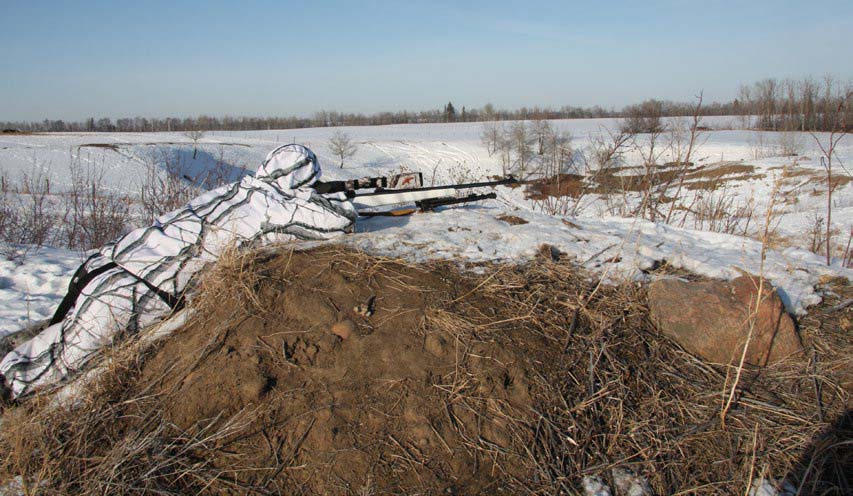
The call continued to play and, after 25 minutes, I switched over to a pup in distress call. I knew there were more coyotes in the valley, it would only be a matter of time before they would show. In my experience, the one vocalization that closes the deal more than others, is the KiiYii. With a series of suffering whimpers echoing down the valley, indeed at the 30-minute mark a lone female appeared on the creek bottom 200 yards to the south. Steady and intentional, she made her way toward the sound. At 70 yards she jumped up on the bank and advanced through the tangled shrubbery. With ample time to prepare, Rick had followed this coyote with his scope trained on the prize for several minutes and, at just the right moment, when she was quartered toward at 60 yards, he squeezed. A well-placed round from his .243 dropped the coyote in its tracks! Elevation and a medley of natural sounds from the e-call had brought in two different coyotes and allowed us to take one home.
Elevation an Asset
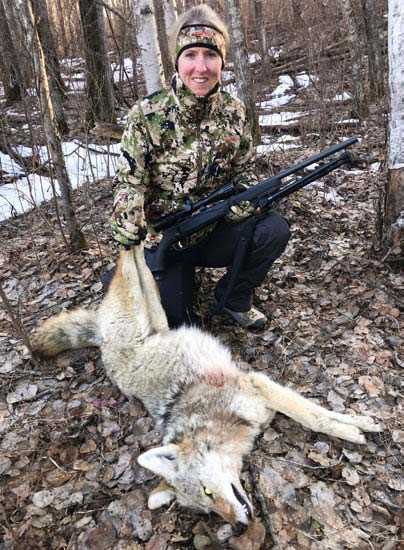
Two of the biggest barriers to shot opportunities are lack of visibility and acoustics. Coyotes are small animals and they can easily elude the hunter by sneaking through tall grass and subtle contours in the landscape. Any time we take a stand, it’s important to choose a place that offers a decent vantage point. Wide-open, flat fields may not be an issue. Coyotes are often easy to spot in this type of habitat, however if you’re overlooking pastureland where wild grasses, clumps of scrub brush or willow stands are prevalent – or simply overlooking hills and valleys – then using a height advantage is paramount. Again, this was one of the most vital contributors to our success during the hunt I just shared.
Not all topography allows for an elevated stand position, but where it does, it is equally important to sit against a tree or other backdrop, or even better yet lie down flat to shoot prone from a position above their line of sight. Often when we post up in an elevated spot, we risk our silhouette being visible on the skyline. Even from a higher point, we still need to take measures to blend in with the surroundings. One of the reasons we were successful on that hunt, was our ability to see the coyotes approaching. Had we been down in the bottom of the valley, we may not have seen either of them come to the call.
The second thing elevation does is allow the breeze or wind to carry the shooter’s scent away and often over top of any approaching coyotes. Savvy hunters are acutely aware of this wild canine’s sensitive nose. Incoming coyotes will often work their way downwind to confirm authenticity of the calls. On many occasions I’ve seen them circle downwind to catch scent. Without fail, as soon as they detect a human’s foul odor, it’s like they hit a brick wall and can’t escape fast enough!
In most situations I try to place the e-call on a knoll or ridgeline, some place that allows the sound to project well. Placing it in a basin or low spot can work but most – at least to some extent – often muffles the sound. At times this can be desirable, but most often we want those recorded sounds to travel as far as possible.
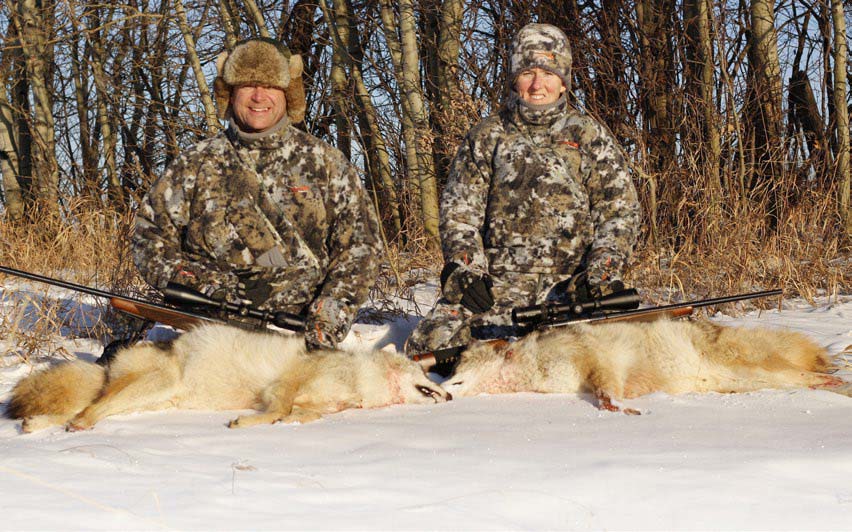
A Roster of Sounds at Your Fingertips
I have mixed feelings about today’s technological advancements in the world of hunting. So much of it takes the guesswork out of the hunt and, to a great extent, eliminates much of the skill. For many years I used a mouth call for coyotes, but I have to say I’m a firm believer in the diversity offered by today’s electronics. Given our rising predator populations, I believe it is not only important, but vital that we capitalize on every tool at our disposal to lawfully cull these wild dogs.
With the robust inventory of coyote vocalizations, including a long list of predator and prey species that can be played during any given session, e-calls continue to revolutionize coyote hunting. For those who have learned to use them correctly, its akin to playing an instrument – hit the right notes at the right time, and it can be music to a coyote’s ears, bringing them in on a string. Hit the wrong ones, and they will run and hide. Certainly, there are times and places where mouth calls outperform, but e-calls offer unparalleled versatility. For instance, on a recent hunt, I used a cottontail distress call and ran a pup in distress call simultaneously. Within minutes a finely furred female emerged from the woods and eagerly trotted up to the call. Almost impossible to replicate that combination and clarity of these natural distress sounds using mouth calls alone, it’s tough to argue with results.
E-calls allow us to manipulate the volume, all at the press of a button. Depending on the preferred call, we can load it with scores of different sounds from coyote yips, howls, barks, and KiiYiis, to bird and other small game distress sounds, an assortment of scavenging birds, deer and elk distress sounds, and many more. As a rule, you get what you pay for, but variety is key when different situations call for a variety of sounds.
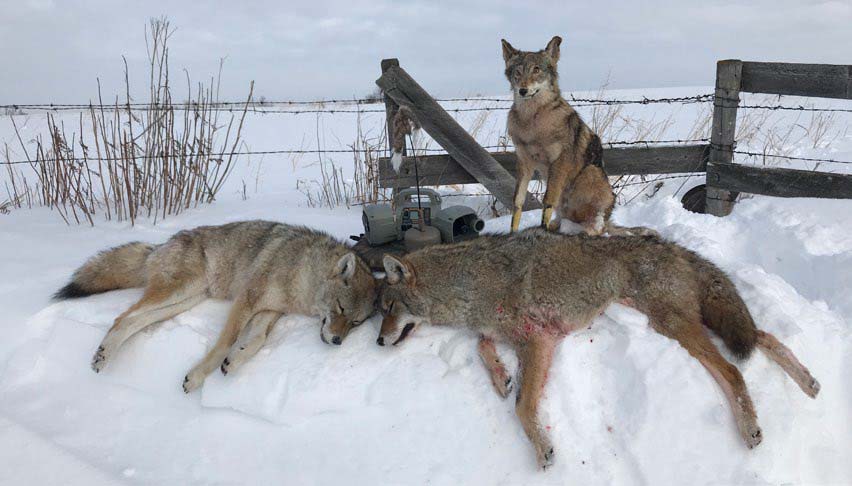
Think Outside the Box
With the growing popularity of e-calls, its important to recognize that just about every hunter has one. Most are limited in the number of sounds they have, so the majority of would-be fur takers are employing a cottontail or jackrabbit in distress sound. Know that from December (and often earlier) through February (and often later), every coyote around has probably heard these sounds many times over. In turn, they are quickly educated making these sounds far less effective as the winter wears on. In the natural world, predators respond to an almost unlimited number of audible cues from birds in distress, to rabbits, and deer, elk, and moose. During the breeding season from mid-January to late February, coyote howls, yips, barks, and assorted invitations and challenges are king. The beauty is that these are all available as digital files that can be loaded on to most e-calls, giving coyote hunters the precise inventory of sounds they want to use in the field.
Knowing that every prey species makes some kind of noise can help us apply those sounds to attract coyotes. Further, if we think about scavenging birds and how they behave on a carcass, we can emulate those sounds. Coyotes readily respond and frequently come to investigate when they hear congregations of crows, magpies, and ravens.
Also recognizing that coyotes are territorial, defensive, predatory, and social helps us sort out which coyote vocalizations to use when. For instance, during their breeding period a female invitation or a lonesome howl, can sometimes be a slam dunk, but so too can a coyote pair howling. Barks tend to be recognized as warning sounds, but used appropriately, they can also excite an incoming coyote to sneak in closer for a better look at what’s going on.
If you are interested in really interacting with coyotes and learning to call them in, consider incorporating electronics into your hunt strategy. Whether you have the opportunity to climb up high on hilltops, river banks, or even utilize tree stands or hides to look down on approaching coyotes, or simply capitalize on slightly higher ground that gives you a modest advantage, remember that elevation is your friend. Mix in a medley of natural sounds using your e-call, add in a measure of patience and, chances are you’ll bring one or more coyotes in on the run the next time you are out predator hunting.
By Kevin Wilson
Per our affiliate disclosure, we may earn revenue from the products available on this page.

